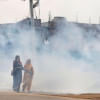Checking Unfit, Outdated Vehicles: Govt failure lets air pollution rise

As residents of Dhaka city remain exposed to high levels of air pollution, some government actions are worsening the problem and putting people's lives at risk.
When the government in August backtracked on the decision to cap the life of commercial vehicles, it basically allowed tens of thousands of decades-old vehicles to be on roads with engines that cause more pollution, experts say.
Old vehicles and the ones with faulty engines are the main polluters of air in the city, says Prof Abdus Salam, who teaches chemistry at Dhaka University.
Besides, the authorities do not have the tools to check a vehicle's emissions, experts say.
CNG (compressed natural gas) is cleaner than diesel and petrol. But the number of vehicles using CNG is falling due to its rising prices and a lack of incentive for choosing cleaner energy, say transport sector insiders.
Air pollution is one of the greatest environmental risks to health, and Dhaka which has over two crore residents often tops the list of cities with the poorest air quality, according to Air Quality Index (AQI) data.
Prof Salam says older vehicles tend to emit more toxic gases due to incomplete combustion of fuel. The older the vehicle, the more pollution it causes, he adds.
"If we want to control air pollution in Dhaka, we must reduce the number of unfit and outdated vehicles," Prof Salam says.

UNFIT AND OUTDATED VEHICLES
The number of vehicles without fitness certificates is growing, shows data from Bangladesh Road Transport Authority (BRTA).
As of April this year, about 5.68 lakh registered vehicles did not have fitness certificates, meaning the vehicles had not gone through fitness checks. The number was 5.08 lakh in January last year.
According to transport sector insiders, there are thousands of unregistered vehicles in the country, and the authorities do not have any idea about the state of those vehicles.
Moreover, BRTA's fitness checks are questionable, says transport expert Prof Hadiuzzaman. "The BRTA does not have the tools to check certain things of a vehicle," he says.
The BRTA has only one Vehicle Inspection Center (VIC), and even that is not fully functional. As a result, almost all the checks are done manually before fitness clearances are given.
"But emissions cannot be measured manually. This means they [BRTA] can't ascertain the level of pollution a vehicle is causing," he said.
The government in May this year announced that it has capped the life of buses at 20 years and trucks and lorries at 25, aiming to reduce crashes and pollution.
In April, over 74,000 registered buses, trucks and other commercial vehicles were past their economic lifespan and the vehicles were supposed to go under crushers.
But the government backtracked from the move amid pressure from transport associations.
Prof Hadiuzzman says the maintenance cost of a vehicle multiplies when it has passed its economic lifespan, and many owners do not spend the money needed for maintenance.
The vehicles that are not properly maintained tend to cause more pollution. This is why the decision of not stopping the operation of outdated vehicles is worsening pollution, he adds.
"So, the policy makers are, directly or indirectly, responsible for air pollution in the city. They can't escape responsibility for health risks faced by thousands of people."
FEWER CNG-RUN VEHICLES
Transport sector insiders say the number of CNG-run vehicles, especially buses, minibuses, and trucks has sharply fallen over the last few years.
Hardly any bus or truck uses CNG now, says Farhan Noor, general secretary of Bangladesh CNG Station Owners Association, adding that the government should incentivise vehicles that use CNG.
He blames the rising prices of CNG and the government decision to keep the refilling stations closed for five hours every day for the waning popularity of CNG.
According to Rupantarita Prakritik Gas Company Limited (RPGCL), there were 5.07 lakh vehicles with CNG kits as of May this year. But the company does not know how many vehicles still use CNG as fuel.
However, the energy ministry, citing BRTA data, in a report last year said only 2.38 lakh vehicles were actually using CNG.
In the 2021-22 fiscal year, only 642 vehicles were fitted with kits to run on CNG. The number was 37,368 in 2014-15, shows RPGCL data.
The RPGCL cancelled registration of 121 CNG conversion workshops for not starting operation after getting approval.
Contacted yesterday, BRTA Chairman Nur Mohammad Mazumder said the authority was taking measures to curb air pollution.
The BRTA will open a VIC at its Mirpur office on October 19, he said.
"We have taken steps to set up eight more VICs at different BRTA offices. We hope those will come into operation in two or three years," he said.
Gradually, there will be a VIC at every BRTA office in the country, he said.
The BRTA sought tools for testing vehicles' emissions from the Department of Environment, he said. "As we didn't get a reply, we decided to procure the kit ourselves."
BRTA's mobile courts now take action against vehicles that emit black smoke that can be seen with the naked eye.
About the large number of vehicles that do not go through fitness tests, he said one-third of the vehicles without fitness papers may not be in use any more.
The BRTA is updating its data, he said, adding that vehicles without fitness certificates are penalised regularly.
As to why the decision of capping the life of commercial vehicles was changed, he said the government backtracked on the decision because transport owners assumed that it would lead to a crisis of vehicles.
The Road Transport and Highways Division formed a committee led by the BRTA chairman to discuss with the stakeholders and recommend how the economic life of commercial vehicles can be capped, he said.
"The committee has already held a meeting, and we will give our opinion soon."

 For all latest news, follow The Daily Star's Google News channel.
For all latest news, follow The Daily Star's Google News channel. 









Comments